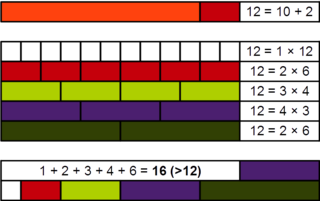
In mathematics, the Fibonacci numbers, commonly denoted Fn , form a sequence, the Fibonacci sequence, in which each number is the sum of the two preceding ones. The sequence commonly starts from 0 and 1, although some authors omit the initial terms and start the sequence from 1 and 1 or from 1 and 2. Starting from 0 and 1, the next few values in the sequence are:

In number theory, Euler's totient function counts the positive integers up to a given integer n that are relatively prime to n. It is written using the Greek letter phi as or , and may also be called Euler's phi function. In other words, it is the number of integers k in the range 1 ≤ k ≤ n for which the greatest common divisor gcd(n, k) is equal to 1. The integers k of this form are sometimes referred to as totatives of n.
In modular arithmetic, a number g is a primitive root modulo n if every number a coprime to n is congruent to a power of g modulo n. That is, g is a primitive root modulo n if for every integer a coprime to n, there is some integer k for which gk ≡ a. Such a value k is called the index or discrete logarithm of a to the base g modulo n. So g is a primitive root modulo n if and only if g is a generator of the multiplicative group of integers modulo n.

In number theory, an abundant number or excessive number is a number for which the sum of its proper divisors is greater than the number. The integer 12 is the first abundant number. Its proper divisors are 1, 2, 3, 4 and 6 for a total of 16. The amount by which the sum exceeds the number is the abundance. The number 12 has an abundance of 4, for example.
In mathematics, a semiprime is a natural number that is the product of exactly two prime numbers. The two primes in the product may equal each other, so the semiprimes include the squares of prime numbers. Because there are infinitely many prime numbers, there are also infinitely many semiprimes. Semiprimes are also called biprimes.

The Lucas numbers or Lucas series are an integer sequence named after the mathematician François Édouard Anatole Lucas (1842–1891), who studied both that sequence and the closely related Fibonacci numbers. Lucas numbers and Fibonacci numbers form complementary instances of Lucas sequences.

In mathematics, and specifically in number theory, a divisor function is an arithmetic function related to the divisors of an integer. When referred to as the divisor function, it counts the number of divisors of an integer. It appears in a number of remarkable identities, including relationships on the Riemann zeta function and the Eisenstein series of modular forms. Divisor functions were studied by Ramanujan, who gave a number of important congruences and identities; these are treated separately in the article Ramanujan's sum.
In mathematics, and more particularly in number theory, primorial, denoted by "#", is a function from natural numbers to natural numbers similar to the factorial function, but rather than successively multiplying positive integers, the function only multiplies prime numbers.
400 is the natural number following 399 and preceding 401.
500 is the natural number following 499 and preceding 501.
In mathematics, a noncototient is a positive integer n that cannot be expressed as the difference between a positive integer m and the number of coprime integers below it. That is, m − φ(m) = n, where φ stands for Euler's totient function, has no solution for m. The cototient of n is defined as n − φ(n), so a noncototient is a number that is never a cototient.
A highly totient number is an integer that has more solutions to the equation , where is Euler's totient function, than any integer below it. The first few highly totient numbers are

In number theory, the nth Pisano period, written as π(n), is the period with which the sequence of Fibonacci numbers taken modulo n repeats. Pisano periods are named after Leonardo Pisano, better known as Fibonacci. The existence of periodic functions in Fibonacci numbers was noted by Joseph Louis Lagrange in 1774.

In number theory, a branch of mathematics, the Carmichael functionλ(n) of a positive integer n is the smallest positive integer m such that
In number theory, a branch of mathematics, a highly cototient number is a positive integer which is above 1 and has more solutions to the equation
In mathematics, a prime power is a positive integer which is a power of a single prime number. For example: 7 = 71, 9 = 32 and 64 = 26 are prime powers, while 6 = 2 × 3, 12 = 22 × 3 and 36 = 62 = 22 × 32 are not.
A Giuga number is a composite number n such that for each of its distinct prime factors pi we have , or equivalently such that for each of its distinct prime factors pi we have .
In number theory, the Dedekind psi function is the multiplicative function on the positive integers defined by
In mathematics, the Fibonacci numbers form a sequence defined recursively by:
In number theory, the totient summatory function is a summatory function of Euler's totient function defined by:










